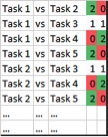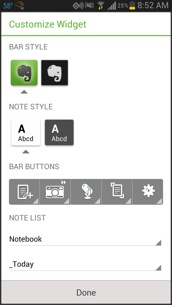With so much feedback about Evernote, I decided to ask David Findlay to write a guest post about how he uses Evernote.
I got my first job when I was 17, filling shelves on Saturday nights in a supermarket. The incompletes in my world were obvious and needed no tracking. Empty shelves here, pallets loaded up with new stock over there — combine the two, fast and neatly enough to appease the over-zealous shift manager.
I’ll turn 30 in a few months as the Business Manager for a not-for-profit group that includes a multi-site church, a crisis-relief charity and a registered training organization working with the long-term unemployed. I also play drums with a local jazz big band and do life with a wife and two small, energetic kids (pocket rockets). Life is busy. I have more inputs arrive in my world in the average waking hour than I used to receive in a week as a 17-year-old supermarket employee.
Evernote holds my trusted system
Evernote holds my trusted system for practicing GTD — for dealing with all these inputs and converting them from amorphous “stuff” into precise action and follow-up. It works in partnership with my brain — which is not bad at assessing, deciding things and asking questions, but is hopeless at coping with large incoming volumes of disconnected information, storing that information and retrieving it quickly.
I also take my use of Evernote further than many people do by keeping ALL my personal filing in Evernote, as well as health and exercise logs, personal journal, sheet music* and random thoughts that might become something I present to my team at work, something I write about or simply something I come back to and reflect on a month or two later.
How I interface with Evernote
I get stuff IN to Evernote primarily through email and scanned paper. These are my two primary collection buckets, and it’s here that I decide something is worth acting upon, or may be later, and then feed it to Evernote for tracking. Evernote’s Windows app by itself has some value as a collection bucket, and the mobile app is useful when traveling or in meetings, but most of the time they’re all outshone by email and scanned paper, in my mind. Press a button on your scanner or forward to your Evernote email address, and it’s all waiting for you in Evernote.
The Evernote email address is far and away the best feature of Evernote. Because every app, blog, share button, content hosting site, social network, security alarm and internet-enabled doohickey allows you to send at least a link (or in many cases, full content or logs) via email, you have an automatic way to post information directly to Evernote, almost regardless of where it is.
I organize content in Evernote primarily through notebooks for incompletes — one for each horizon of focus, with a notebook stack at the top for next actions, containing one for each context. I also have a single notebook for filing, which is organized by tags. I use note-linking** to link task notes back to projects, and to link projects back to Areas of Focus or 1-2 year Goals. This helps me to retain some sense of purpose and connection up and down the six Horizons of Focus — that deadline I’m working back late to meet or thorny policy issue I’m pushing (to the unified groans of colleagues) may actually have some significance in the context of a 2-year goal I’ve set. This kind of big-picture motivation is sorely underrated.
Filing – Garbage in, garbage out.
The archivist in me always recommends that people take care to make sure their “filing” notes are titled and ordered consistently. Once you start dealing with a large number of notes (say, 2000+) then searching — and even tagging, if done sensibly — might only narrow things down to the nearest 30 to 50 notes. The ability to eyeball a list of six-year-old notes that long and know exactly what’s in each one without having to physically open them is a rare and valuable gift you should give to your future self.
Attachments – Use them for templates
Nearly a year ago I began the adventure of templating many of the repetitive tasks I do. I now keep these templates in Evernote, including partially filled forms that I regularly submit, standard-form contracts, report templates and Outlook email templates for messages I need to send often***. I also use a note template for when I’m starting a new project, which forces me to articulate the scope of the project, the successful outcome and a sequence of next actions — or sub-projects — that need to happen to get it moving.
Time-sensitive reminders
I use email through followupthen.com constantly to remind me of deadlines, and as a tickler file of sorts, to bring back to my attention info that will be useful at a known time down the track, but not now. I often email Evernote links to followupthen.com, knowing that at the set time I’ll be able to click straight to my thoughts or files on the task I need to deal with. One recent example — I used follow-up then to receive a link to the note in which I filed the tickets for the Coldplay concert, purchased nearly a year ago, to pop up in my inbox with a reminder to print them, a few hours before we had to leave for the event.
The rewards of Long-term use of Evernote
The simple act of repeatedly collecting useful information and having it made accessible at a moment’s notice brings significant rewards over time. This immediate, anywhere access is a benefit of Evernote that’s not available through many other formats in which people might hold their trusted system.
I’ve found that I could retrieve the contact details of a mechanic I used years ago (couldn’t remember his name, only the work he did on my car), based on an old service docket I kept. I could remember the words to a song I played years ago because I kept the sheet music for it in Evernote, and I could find it at the time the song was actually stuck in my head on a car ride. I could contribute valuable material in a strategic regional meeting for our movement, because I had taken notes in Evernote during a seminar I attended eighteen months ago in which a high-level administrator had covered exactly the topic being discussed. I could make decisions quickly while filing my tax return, find out what I claimed last year and what documentation I kept for it, then decide if the same thing applies this year, because it’s all in Evernote.
Novel uses for Evernote
Delayed departmental reports
When I have a colleague coming back from annual leave and I want to notify them of any key developments or progress made in their area while they were gone, I’ll write the report up in a note in Evernote. Then I’ll create a public link of the note, and shorten it using clockurl before emailing it to them, so the link won’t become accessible until 8am on the morning of their return. This helps me prepare ahead of time so it’s no longer on my mind, while protecting their serenity for the last few days of their break.
(Not) Health logs
There are a many tracking apps out there for recording your diet and exercise (and in fairness, a few of them are really good), but during periods when I’m tracking these things closely, I’ll write the particulars out in a note. No need to complicate things, or add another app to my phone or another collection bucket. The most viscerally impacting of these are some 4-Hour Body binge day logs from my last weight-loss experiment. Any time I struggle for dietary motivation, I revisit all the tragic lists of garbage I ate on prescribed binge days, complete with their approximate caloric contents. 2,500 calories of custard-crème-filled donuts in one two-hour session? Thank you — I’m going to go and eat an entire head of lettuce right now.
Evernote, in the beginning, was nothing more than a way to practice GTD that appealed to my nerdier side. None of my colleagues used it (which made it so much cooler, somehow). There’s a good reason why it’s become mainstream, and why I’ve stuck with it longer than any other piece of self-management software: it handles with excellence the things my brain doesn’t do at all well. It makes me look better than I really am.
* Sheet music stored in Evernote and read on a tablet is a useful practice tool. Don’t use it on stage, though — the screen glow from your tablet annoys the lighting tech and it’s nigh impossible to reliably flick pages during the more difficult pieces in between strokes with your left hand.
** There’s enough friction in this action that it only gets maintained and updated during a weekly review. Hence, missing or rushing a weekly review always results in lost perspective, not just control.
*** I’d prefer to use mailto: links instead of templates, but sadly Evernote’s Windows app won’t let you add &subject= and &body= arguments to these, so I can’t template a full email using a link. Outlook’s .oft templates are the next best thing, although you have to recreate them any time you want to make changes.














